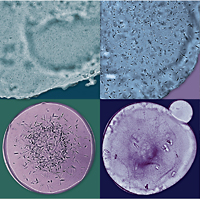

LCP Protocols >> Lipid Mixing
Lipid Mixing Method
The procedure described here can be used to supplement monoolein or any other LCP host lipid with lipophilic additives. Such additives can modulate properties of LCP or can preferentially interact with proteins reconstituted in LCP and therefore are useful for optimization of crystallization conditions. Cholesterol was found to be the best lipid additive significantly improving the β2AR-T4L crystal size (Cherezov et al., 2007; Hanson et al., 2008). Cholesterol was also used for crystallization of adenosine A2A receptor (Jaakola et al., 2008). Compatibility of monoolein-based LCP with several lipid-like molecules was reported in Cherezov et al., 2002.
MATERIALS:
- Monoolein (1-oleoyl-rac-glycerol) (Sigma or Nu-Chek Prep).
- Additive lipids (Sigma or Avanti Polar Lipids).
- Chloroform (HPLC grade, Sigma).
PROCEDURES:
- Weigh a small amount (few mgs) of an additive lipid in a small (1-2 mL) amber glass vial with a Teflon-lined cap.
- Add an appropriate amount of monoolein to obtain required concentration of the additive lipid (Do not exceed 100 – 200 mg of total lipid mixture per vial, otherwise, a complete removal of solvent will be difficult. Use several vials or a larger volume vial for making stocks in excess of 200 mg of mixed lipids).
- Dissolve the lipids in ~200 - 400 μL of chloroform.
- Evaporate bulk of the solvent using a gentle stream of dry, filtered nitrogen, keeping the vial warm (~37 °C) to prevent lipid from freezing.
- Remove the last traces of chloroform under a vacuum (<100 mTorr) for at least 4 hours (preferably overnight).
- Flush the vial with argon gas, close the cap and store at -20 °C or lower temperature until used.
For additional details see Caffrey and Cherezov, 2009.
References
Caffrey, M., and V. Cherezov. (2009) Crystallizing membrane proteins using lipidic mesophases. Nat. Protoc. 4: 706-731. >>
Cherezov, V., Clogston, J., Misquitta, Y., Abdel-Gawad, W., and M. Caffrey. (2002) Membrane protein crystallization in meso: lipid type-tailoring of the cubic phase Biophys. J. 83: 3393-3407. >>
Cherezov, V., Rosenbaum, D.M., Hanson, M.A., Rasmussen, S.G., Thian, F.S., Kobilka, T.S., Choi, H.J., Kuhn, P., Weis, W.I., Kobilka, B.K., and R.C. Stevens. (2007) High-resolution crystal structure of an engineered human β2-adrenergic G protein-coupled receptor. Science 318: 1258-1265. >>
Hanson, M.A., Cherezov, V., Griffith, M.T., Roth, C.B., Jaakola, V.P., Chien, E.Y., Velasquez, J., Kuhn, P., and R.C. Stevens. (2008) A Specific Cholesterol Binding Site Is Established by the 2.8 A Structure of the Human β2-Adrenergic Receptor. Structure 16: 897-905. >>
Jaakola, V.P., Griffith, M.T., Hanson, M.A., Cherezov, V., Chien, E.Y., Lane, J.R., Ijzerman, A.P., and R.C. Stevens. (2008) The 2.6 Angstrom Crystal Structure of a Human A2A Adenosine Receptor Bound to an Antagonist. Science 322: 1211-1217. >>
CONTACT US: USC | Cherezov Lab | cherezov@usc.edu